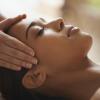CYBERMED LIFE - ORGANIC & NATURAL LIVING
CYBERMED LIFE - ORGANIC & NATURAL LIVING
 Craniosacral therapy (CST) is a form of bodywork or alternative therapy using gentle touch to palpate the synarthrodial joints of the cranium. A practitioner of cranial-sacral therapy may also apply light touches to a patient's spine and pelvic bones. Practitioners believe that this palpation regulates the flow of cerebrospinal fluid and aids in "primary respiration". Craniosacral therapy was developed by John Upledger, D.O. in the 1970s, as an offshoot osteopathy in the cranial field, or cranial osteopathy, which was developed in the 1930s by William Garner Sutherland.
Craniosacral therapy (CST) is a form of bodywork or alternative therapy using gentle touch to palpate the synarthrodial joints of the cranium. A practitioner of cranial-sacral therapy may also apply light touches to a patient's spine and pelvic bones. Practitioners believe that this palpation regulates the flow of cerebrospinal fluid and aids in "primary respiration". Craniosacral therapy was developed by John Upledger, D.O. in the 1970s, as an offshoot osteopathy in the cranial field, or cranial osteopathy, which was developed in the 1930s by William Garner Sutherland.
According to the American Cancer Society, although CST may relieve the symptoms of stress or tension, "available scientific evidence does not support claims that craniosacral therapy helps in treating cancer or any other disease". CST has been characterized as pseudoscience Cranial osteopathy has received a similar assessment, with one 1990 paper finding there was no scientific basis for any of the practitioners' claims the paper examined.